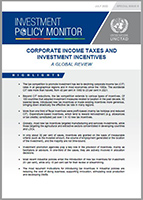
Foreign investors base their decision to enter a country on many factors, including political stability, economic potential, natural resources, transparency and efficiency of regulatory regimes and the level of infrastructure and skills.
The tax regime is also a factor in investment decisions, and although tax incentives are frequently far from being the most important one in comparison with factors such as political stability and security, a stable and transparent legal and regulatory environment and the quality of infrastructure and skills, they have traditionally been one of the most widespread policy tools to attract and retain foreign investment.
The pandemic has accentuated the importance of incentives and tax relief efforts as part of the economic recovery and resilience packages adopted worldwide.
This Special Issue of the Investment Policy Monitor expands on the findings and analysis presented in the World Investment Report 2022: International Tax Reform and Sustainable Investment.
Highlights
- The tax competition to promote investment has led to declining corporate income tax (CIT) rates in all geographical regions and in most economies since the 1980s. The worldwide CIT rate more than halved, from 40 per cent in 1980 to 23 per cent in 2021.
- Beyond CIT reductions, the tax competition extends to various types of incentives. Of 100 countries that adopted investment measures related to taxation in the past decade, 90 lowered taxes, introduced new tax incentives or made existing incentives more generous, bringing down drastically the effective tax rate in many regions.
- More than one third of fiscal incentives were profit-based (mainly tax holidays and reduced CIT). Expenditure-based incentives, which tend to reward reinvestment (e.g. allowances or tax credits) constituted just over 1 in 10 new tax incentives.
- Globally, most new tax incentives targeted manufacturing and services investments, while those targeting the agricultural and extractive sectors concentrated in developing countries and LDCs.
- In only about 30 per cent of cases, incentives are granted on the basis of measurable criteria (such as the invested amount, the volume of employment generated or the location of the investment), and the majority are not time-bound.
- Investment promotion agencies play a key role in the provision of incentives, mainly as facilitators or advisors. In one-third of the cases, they are actively involved in allocation decisions.
- Most recent industrial policies entail the introduction of new tax incentives for investment (61 per cent), while only 15 per cent call for their review or streamlining.
- The most recurrent motivations for introducing tax incentives in industrial policies are reducing the cost of doing business, supporting innovation, stimulating local production and developing SMEs.




